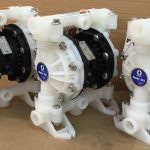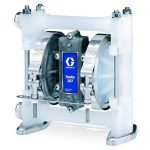Como já sabemos, a bomba pneumática de diafragma é um equipamento extremamente versátil e que pode ser implementado em diversos setores da indústria. Desenvolvida para transferência eficiente de líquidos de diversas viscosidades e temperaturas. O seu design funcional permite uma utilização fácil e intuitiva. Entretanto, alguns problemas comuns das bombas pneumáticas de diafragma podem surgir.
To help you resolve this situation, we have separated the main problems that can affect a pneumatic diaphragm pump and the best way to resolve them. With this, you will be able to guarantee the maximum performance of the equipment and increase its useful life in the best possible way, ensuring that the pump delivers versatility and efficiency for much longer.
Air pressure and line size
In order for your pump to guarantee its efficient operation, it is essential that the air inlet pressure adapts to the characteristics and needs of the pump. This is because insufficient pressure will reduce the flow rate and pressure exerted within the equipment, impacting the performance and productivity of your industry.
To solve this problem, it is necessary to check the line size determined in your pump manufacturer's specifications so that the inlet air pressure is adequate. This way, you avoid restrictions and increase the productivity of your equipment.
Easy Troubleshooting Tips for Air Diaphragm Pumps – Part
The biggest cause of leaks in pneumatic diaphragm pumps is defects in the gaskets. Depending on the fluid that is pumped, leakage can be a major problem, considering that several industries pump dangerous or flammable chemical fluids.
To avoid leaks, it is essential to ensure that all joints on your pneumatic diaphragm pump are properly tightened, in order to avoid accidents within your industry. In more robust operations, some components must be replaced occasionally to prevent this problem from occurring.
Correct pipe size
The piping used in the pneumatic diaphragm pump has specific characteristics depending on the manufacturer and model of your pump. For this reason, it is necessary to check the size of the piping used so that your pump does not have performance problems or suffer from cavitation.
To eliminate this risk, it is necessary to follow all the recommendations of the manufacturer of your pneumatic diaphragm pump and use the piping within the dimensions.
Screw Tightening
Vibration and forces generated during operation can cause screw tightening to loosen over time. This problem will reduce the pressure on the equipment's sealing surface and favor the incidence of leaks. Although it can happen in any type of pneumatic diaphragm pump, loose screws are very common in plastic pumps, mainly due to the material.
This problem can be avoided through a preventive maintenance process. This means that it is necessary to periodically tighten the screws to avoid problems caused by loosening. This means the sealing surfaces will remain secure and your pump will perform as expected.
Freezing
Membrane pumps operating in humid environments or at low temperatures may suffer from freezing of the structure. This freezing will impact the functioning of your equipment and reduce its useful life.
In this case, it is necessary to reduce the inlet pressure of your pump to avoid freezing during operation. To do this, you can adjust the configuration of your compressor or use a pressure regulator coupled to the equipment. If this is not possible, a larger pump that can deliver greater speed during operation can also be implemented.
Check valve problems
The main purpose of the check valve is to allow fluid flow and prevent its return to the equipment. However, like other components, the check valve is also subject to failure and damage, which can harm the proper functioning and performance of your equipment.
Failures in the check valve are usually caused by debris or fragments that obstruct its ball, damaging the seal. This way, you could end up suffering from a fluid leak, which represents not only a financial loss for your industry, but also a risk for workers.
Just as it should be implemented in other situations, to avoid check valve failures, it is essential to establish a preventive maintenance process. Installing a filter to reduce the entry of unwanted objects can also help prevent this problem.
Corrosion
One of the main aspects that must be considered when choosing your Focusing on your flow curve is the type of fluid that will be pumped. This is because different compositions of the equipment can affect the pumping of the fluid and the corrosive material can damage your pump.
Pumping corrosive fluids can damage valves and diaphragms and impair the performance of your equipment, which is why it is necessary to consult your pump's chemical compatibility table. If your industry deals with this type of fluid, the stainless steel pumps, polymers or reinforced polyethylene may be a good choice.
Know the DOUBLE DIAPHRAGM PNEUMATIC PUMPS – HUSKY 3300 – GRACO










